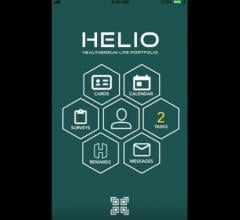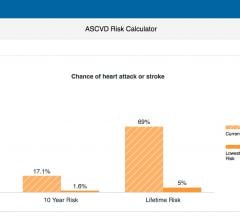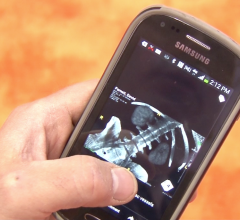October 13, 2014 — Although cardiovascular disease is largely avoidable through lifestyle modifications, it remains the nation’s number one cause of death. While annual wellness exams offer physicians the chance to advise patients on modifying cardiac risk factors, that advice can easily get lost given the amount of information covered during a routine check-up.
Now, a team of biomedical informaticians, public health experts and primary care doctors from The Ohio State University has found a way to give those heart health messages a boost by implementing a state of the art app that could fundamentally change the way physicians and patients interact with electronic health records (EHR).
Called SPHERE (Stroke Prevention in Healthcare Delivery EnviRonmEnts), the app is able to tap directly into an EHR system in real time and provide physicians and patients with an evaluation of cardiac disease risk. SPHERE transforms a patient’s personal health data into a color-coded cardiac scorecard that can be displayed on a tablet or laptop during the exam, giving physicians a powerful new communication tool.
“You can talk to a patient about needing to change numbers, levels and risk factors — but it’s hard to make that information meaningful,” says primary care physician Michael Langan, M.D., who is helping pilot SPHERE in an outpatient setting at Ohio State’s Wexner Medical Center. “Showing patients a visual of that same information completely changes their level of understanding and engagement.”
Based on the American Heart Assn.’s (AHA) ‘Life’s Simple 7’ risk factors, the experimental app creates the scorecard by pulling patients’ risk factor data from multiple sources within the EHR system, using a “traffic light” color scheme to indicate if factors such as blood glucose, total cholesterol, body mass index and smoking status are at poor (red), intermediate (yellow) or ideal (green) levels. While most of the scorecard is completed with the patient information, the program also allows physicians to manually input data about diet and physical activity, which are also ranked and color-coded. All of the information ultimately combines into a global health indicator score ranging from 1 (red) to 100 (green).
Currently, SPHERE is being used exclusively at Ohio State’s point of care clinics with women over the age of 65. According to Randi Foraker, Ph.D., assistant professor of epidemiology with Ohio State’s College of Public Healthand a secondary appointment in the Department of Biomedical Informatics, this population tends to focus check-ups on topics other than cardiovascular disease — a key factor in why heart issues in women can go undiagnosed. Foraker says SPHERE was designed to change that.
“We developed SPHERE to be more than a static diagnostic or health calculator, but a dialogue driver, with features that prompt patients and their physicians to change how they talk about and respond to cardiac risk factors,” noted Foraker, who is leading the study to evaluate SPHERE’s use in a primary care setting, and is the first author on arecent publication about the development of SPHERE.
One of these features lets users adjust horizontal sliders to manipulate risk factor values, allowing them visualize how lifestyle modifications could reduce — or increase — their chances of having a cardiovascular event.
“Suddenly all these numbers and values become tangible and motivational. We can set weight and dietary goals on the slider and patients can see how their global health indicator changes from red to yellow to green,” said women’s health expert Rebecca Jackson, M.D., director of Ohio State’s Center for Clinical and Translational Science. “SPHERE is one of the first tools we have ever seen that bridges the gap between having all this personal health data at our fingertips and being able to use that data to empower patients to change their behavior.”
Turning Vitals Into Visuals: The Informatics Solution to Jumpstart EHR Evolution
While physicians like Langan and Jackson are excited at the patient care possibilities that a tool like SPHERE offers, the project initially presented challenges for the biomedical informatics team, who were determined to make SPHERE easy to understand, fast and non-disruptive.
“Most hospitals like Ohio State use commercial EHR systems that don’t have a lot of flexibility to add in new parameters or terminology, so our first step was to tap into EHR data” said biomedical informatics researcher Marcelo Lopetegui, M.D., MS.
Lopetegui and the team developed a computer program that allowed web browsers to open inside the EHR system. Using an algorithm based on the AHA ‘Life’s Simple 7’ risk factors, Lopetegui programmed the scorecard and sliders as a stand-alone web-based app that could be opened alongside the medical record.
"At first glance the app functions a lot like an interactive health calculator. But then we added critical behind the scenes programming that turned SPHERE from a health calculator into powerful and persuasive communication tool," said Lopetegui.
Programmers in the biomedical informatics department worked directly with the EHR vendor to push real time medical record data securely to the SPHERE app. Programmers also created a database of regularly updated EHR data on female patients 65+ to help augment the scorecard’s historical information, including relevant data that might have been collected during earlier physician encounters. The result: an instantaneous scorecard prepopulated with up-to-the-minute data.
The next challenge was to integrate SPHERE seamlessly into the physician’s normal workflow without disrupting it. When physicians open the chart of a patient that meets the study criteria, the EHR receives an automatic alert that adds the necessary information to the scorecard. Physicians are prompted to open the scorecard, but can choose if and when to do so. When physicians click the prompt, they can interact with the scorecard and still work in medical record at the same time. If any information changes — test results, lab values, medications that modify risk factors — the scorecard will automatically update.
“Other physicians outside the study group are intrigued by the simple visual and interactive features of SPHERE, and have started asking our team to create other types of specialty and guideline-based scorecards,” said Lopetegui. “So, I’m satisfied that we’ve created an interface that physicians find relevant and useful.”
Biomedical Informatics Department Chair Philip R. O. Payne, Ph.D., says from an informatics perspective, SPHERE marks a turning point in the evolution of EHR in two major ways.
“First, it capitalizes on the benefits of having EHR at the point of care by turning them from a passive record-keeping tool into an active tool used to help in patient-provider decision making,” said Payne, who is also the inaugural Director of the Data Analytics Collaborative, which is part of the Discovery Themes initiative at Ohio State. “It also allows us to harness all of the patient’s historical health information from multiple sources, and look at it holistically to better judge a patient’s risk for disease. These are the kinds of innovations we need in order to maximize the value of EHR and translate that benefit into healthier people.”
Testing, Optimization of SPHERE Continues
Now in a second year of working on SPHERE, the team is currently tracking the program to see how heart health behaviors of women change over time versus women who were not shown the app. The researchers also plan to analyze individual risk factors to see if they can identify patterns that may influence clinical decisions or communication.
“If we find that cardiovascular health as a whole shifts over time, we want to know which primary factors are driving that change. Did the app make a difference by prompting the provider to put a patient on an anti-hypertensive? Did SPHERE motivate a patient to lose weight?” said Foraker.
Currently SPHERE doesn’t push data back to the EHR, and the team is hoping to develop a way to automatically provide personalized health tips to patients based on their scorecard results, so patients could leave the appointment with actionable information in hand.
Working closely with Langan, Foraker is also figuring out a way to bring SPHERE to a broader and younger patient population, noting that some risk factors are easier to change when modified earlier in life.
“Less than one percent of the American population is in optimal cardiac health. If SPHERE could help change that, it would be a major step towards stopping the epidemic,” said Foraker. “And it would show that when the EHR connects people with data in meaningful ways, it does have the ability to impact care and outcomes.”
The SPHERE project was supported by funding from Pfizer Inc. Additional collaborators include The Ohio State University Center for Clinical and Translational Science, Abigail Shoben, Ph.D., Division of Biostatistics, Ohio State University College of Public Health; Albert Lai, Ph.D., Ohio State University Department of Biomedical Informatics, Marjorie Kelley, RN, Ohio State University Department of Biomedical Informatics; Caren Roth, MPH, Ohio State University Department of Biomedical Informatics; and Hillary Tindle, M.D., MPH, Division of General Internal Medicine, University of Pittsburgh.
For more information about educational opportunities,r esearch projects and funding opportunities within theDepartment of Biomedical Informatics, please contact us at [email protected]
For more information: ccts.osu.edu


 April 05, 2019
April 05, 2019 








